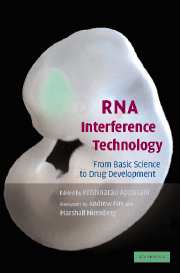Book contents
- Frontmatter
- Contents
- Foreword by Andrew Fire
- Foreword by Marshall Nirenberg
- List of Contributors
- Introduction
- Section one Basic RNAi, siRNA, microRNAs and gene-silencing mechanisms
- Section two Design, synthesis of siRNAs
- Section three Vector development and in vivo, in vitro and in ovo delivery methods
- 10 Six methods of inducing RNAi in mammalian cells
- 11 Viral delivery of shRNA
- 12 siRNA delivery by lentiviral vectors: Design and applications
- 13 Liposomal delivery of siRNAs in mice
- 14 Chemical modifications to achieve increased stability and sensitive detection of siRNA
- 15 RNA interference in postimplantation mouse embryos
- 16 In ovo RNAi opens new possibilities for functional genomics in vertebrates
- Section four Gene silencing in model organisms
- Section five Drug target validation
- Section six Therapeutic and drug development
- Section seven High-throughput genome-wide RNAi analysis
- Index
- Plate section
- References
11 - Viral delivery of shRNA
Published online by Cambridge University Press: 31 July 2009
- Frontmatter
- Contents
- Foreword by Andrew Fire
- Foreword by Marshall Nirenberg
- List of Contributors
- Introduction
- Section one Basic RNAi, siRNA, microRNAs and gene-silencing mechanisms
- Section two Design, synthesis of siRNAs
- Section three Vector development and in vivo, in vitro and in ovo delivery methods
- 10 Six methods of inducing RNAi in mammalian cells
- 11 Viral delivery of shRNA
- 12 siRNA delivery by lentiviral vectors: Design and applications
- 13 Liposomal delivery of siRNAs in mice
- 14 Chemical modifications to achieve increased stability and sensitive detection of siRNA
- 15 RNA interference in postimplantation mouse embryos
- 16 In ovo RNAi opens new possibilities for functional genomics in vertebrates
- Section four Gene silencing in model organisms
- Section five Drug target validation
- Section six Therapeutic and drug development
- Section seven High-throughput genome-wide RNAi analysis
- Index
- Plate section
- References
Summary
Introduction
The completion of the human genome has made available the sequences of thousands of genes (Baltimore, 2001), allowing researchers to switch focus from identifying genes to understanding their function. In broad terms, gene function studies can be classified into two categories: those where the gene of interest is introduced into a system in which it is not expressed, and those in which the gene is disrupted or removed. While over-expression studies are fairly straightforward, methods for gene inactivation have been hampered in higher eukaryotes by the difficulty in manipulating their genetic material. Thus, although it is possible to generate mice lacking genes of interest by homologous recombination (Capecchi, 1989; van der Weyden et al., 2002), such studies remain technically challenging and expensive. Moreover, in some cases, deletion of a gene may be lethal, preventing its analysis (e.g., Lui et al., 1996). Alternatively, the phenotype produced may differ from that expected in humans (Harlow, 1992; Lee et al., 1992). A simple method for effective genetic inactivation in somatic cells in vitro is greatly needed, but has remained elusive (Sedivy and Dutriaux, 1999). Not surprisingly, recent years have seen considerable interest in a novel method for inactivating gene function in somatic cells that exploits the phenomenon of RNA interference (RNAi), first described by Fire et al. (1998). In their seminal study, they showed that double-stranded (ds)RNA homologous to a gene of interest could inhibit its expression. The dsRNA is digested into 21–23 nucleotide small interfering RNAs (siRNAs).
- Type
- Chapter
- Information
- RNA Interference TechnologyFrom Basic Science to Drug Development, pp. 161 - 173Publisher: Cambridge University PressPrint publication year: 2005
References
- 1
- Cited by



